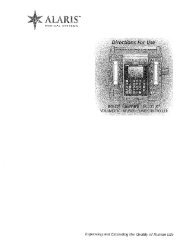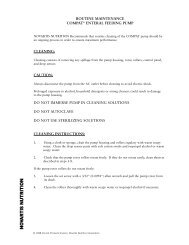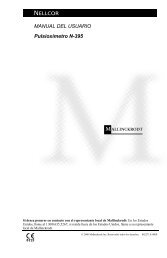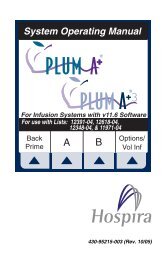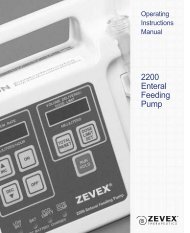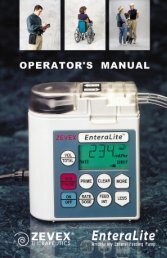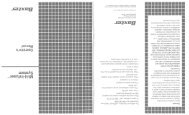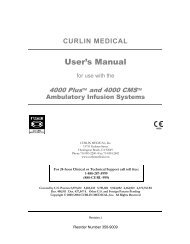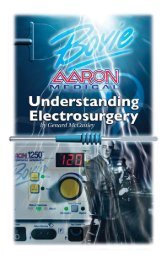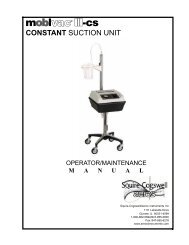Aaron Bovie 950 User Manual - Med-E-Quip Locators
Aaron Bovie 950 User Manual - Med-E-Quip Locators
Aaron Bovie 950 User Manual - Med-E-Quip Locators
- No tags were found...
Create successful ePaper yourself
Turn your PDF publications into a flip-book with our unique Google optimized e-Paper software.
WARNINGS:To reduce the potential for alternate site burns, do one or more of the following:• Avoid skin-to-skin contact points, such as fingers touching leg, when positioning the patient.• Place 5 to 8 cm (2 to 3 in.) of dry gauze between contact points to ensure that contact doesnot occur.• Position the patient return electrode to provide a direct current route between the surgicalsite and the return electrode which avoids skin-to-skin contact areas.• In addition, place patient return electrodes according to the manufacturer’s instructions.Potential for alternate site burns increases if the return electrode is compromised.Do not wrap the accessory cords or patient return electrode cords around metal objects. Thismay induce currents that could lead to shocks, fires, or injury to the patient or surgical team.CAUTIONS:At no time should you touch the active electrode or bipolar forceps. A burn could result.Do not stack equipment on top of the generator or place the generator on top of electricalequipment. These configurations are unstable and/or do not allow adequate cooling.Provide as much distance as possible between the electrosurgical generator and other electronicequipment (such as monitors). An activated electrosurgical generator may cause interferencewith them.Nonfunction of the generator may cause interruption of surgery. A backup generator should beavailable for use.Do not turn the activation tone down to an inaudible level. The activation tone alerts the surgicalteam when an accessory is active.When using a smoke evacuator in conjunction with the electrosurgical generator, place the smokeevacuator a distance from the generator and set the generator volume control at a level thatensures that the activation tones can be heard.The use of high frequency current can interfere with the function of other electromagneticequipment.When high frequency surgical equipment and physiological monitoring equipment are usedsimultaneously on the same patient, place any monitoring electrodes as far as possible fromthe surgical electrodes. Monitoring systems incorporating high frequency current limiting devicesare recommended.Do not use needles as monitoring electrodes during electrosurgical procedures. Inadvertentelectrosurgical burns may result.To avoid the possibility of an electrosurgical burn to either the patient or the physicians, donot allow the patient to come in contact with a grounded metal object during activation.When activating the unit, do not allow direct skin contact between the patient and the physician.Remove any loose fitting jewelry from the patient before activation.Examine all accessories and connections to the electrosurgical generator before use. Ensure thatthe accessories function as intended. Improper connection may result in arcs, sparks, accessorymalfunction, or unintended surgical effects.When not using active accessories, place them in a holster or in a clean, dry, nonconductive,and highly visible area not in contact with the patient. Inadvertent contact with the patient mayresult in burns.Studies have shown that smoke generated during electrosurgical procedures can be potentiallyharmful to patients and the surgical team. These studies recommend adequately ventilating thesmoke by using a surgical smoke evacuator or other means. 11. U.S. Department of Health and Human Services. National Institute for Occupational Safetyand Health (NIOSH). Control of Smoke from Laser / Electric Surgical Procedures. HAZARDCONTROLS, Publication No. 96-128, September, 1996).1-4 <strong>Bovie</strong> / <strong>Aaron</strong> <strong>Med</strong>ical



